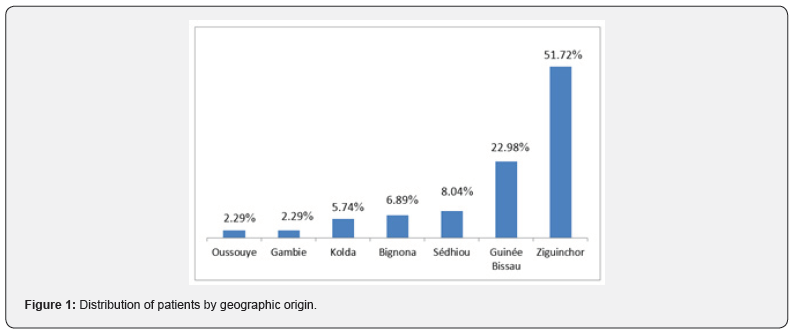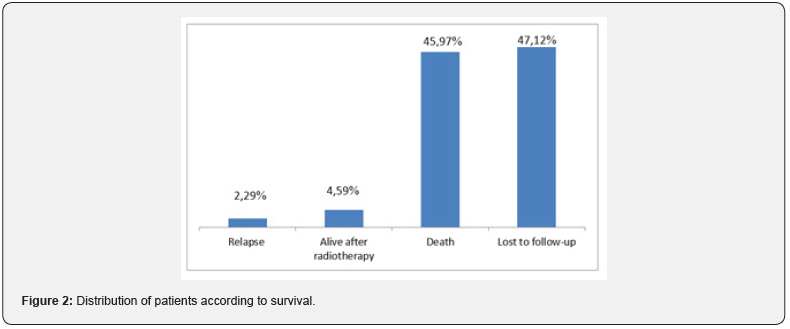Fifty-two (N = 52) of our patients underwent surgery (Figure 3).


Discussion
Epidemiological data
In our study, we obtained a sex ratio of 1.8 for a predominance of men. The male predominance is reported by several authors because of the heavy consumption of tobacco and alcohol among men [6]. In France, the UADT cancers were fourth in men and tenth in women [7]. An African study on breast cancer showed that the most affected social stratum was mostly patients of low socioeconomic level [8]. In the field of ENT cancerology, most cancers affect a population often composed of employees, workers, and unemployed individuals [9]. In Ziguinchor, housewives were the social stratum most affected by cancer. More than half of the patients in our study were from the city of Ziguinchor because our study setting was in the city of Ziguinchor and the Ziguinchor regional hospital is one of the first referral hospitals in the south of Senegal.
Clinical data
The consultation time is defined as the time between the appearance of the first symptom and the first consultation with a healthcare professional [6]. In northern countries such as New Zealand, Canada, Denmark, this period ranges from 46 days to 4 months [6]. In a Malagasy study of UADT cancers, the author stated that it was about 7 months long on average [6]. In our study, it was even longer. A long consultation period delays the diagnosis, so tumor development is not controlled [10]. The diagnosis is most often made at a late stage in patients who are sometimes negligent because the evolution is essentially loco regional cervicofacial, and it is at an already advanced stage that there will be a functional impact on their swallowing and breathing functions [3]. Lesions were either exceeded or inoperable in more than half of our patients. In our context, the regional hospital center of Ziguinchor occupies a strategic place in the south of Senegal. It has a high technical platform compared to other hospital structures in the region.
Patients from remote towns in the region are forced to go there. Geographic inaccessibility and financial difficulties are therefore potential factors for delayed diagnosis. The analysis of survival rates is made difficult by the great heterogeneity of UADT tumors, by the importance of lymphophilia, by the complexity of the treatments implemented and the difficulty of carrying out randomized trials that are extended in the time. For all stages and locations combined, survival remains on average between 30 and 40% at 5 years [3]. Rakotoarivony, in his study on mouth and pharynx cancers stated that survival is very low [11]. The death rate in his study was 21.4% and the loss to follow-up rate was estimated at 75%. In our study, the high death rates 45.97 % and lost to follow-up 47.12% could be related to the financial and logistical difficulties of the patients. Allison attributes this high death rate to the delay of the consultations [12].
Regarding relapses, nearly 90% occur in the first two years after initial treatment [13]. Beyond the period of the first three years during which attention must be paid to the risk of relapse, the surveillance should focus on the detection of a second location whose risk persists over time [14]. In our study, we recorded relapse in 02 patients, four years later.
Diagnostic data
UADT cancers are initially pauci-symptomatic. The unilateral nature and / or the persistence of clinical signs are suggestive and should systematically raise the suspicion of cancer [4]. The definitive diagnosis is anatomopathological and allows to give the histological type [13]. Rakotoarivony [11] considered that the anatomopathological result was a sine qua non for its study on oral cavity and pharynx cancers. In our study, we could only confirm 57.61% of cancers to the histology and the time to obtain pathological results was long. This is because during the first 8 years of our study, there was no anatomopathology laboratory in Ziguinchor. The patients then had to go to Dakar, the capital of the country, to one of the laboratories, to drop off their biopsies or surgical documents. Indeed, Ziguinchor is located about 455 km from Dakar. This major logistical difficulty was a major handicap in the diagnosis of cancers. Potential factors, related to the patient and the health system, delay the diagnosis of UADT cancer [6]. In Ziguinchor, it was about financial, geographic, and logistical difficulties.
Therapeutic data
Depending on the location of the tumor, its stage and the general condition of the patient, the first-line treatment modalities are surgery, radiotherapy, conventional chemotherapy, and targeted therapies [15]. In our study, the low rate of patients having undergone chemotherapy or radiotherapy could be due to the remoteness of the oncology and radiotherapy centers located in the Dakar region. Patients must go there for treatment. Some patients express reservations because of the distance and the fact that they do not know the city of Dakar and have no family there. In Africa, the number of cancer patients is increasing as the cost of treating the disease increases [16]. Chemotherapy is practiced with protocols ranging from the least expensive to the most expensive with costs ranging from 60,000 FCFA (100 Euros) to more than 400,000 FCFA (600 Euros) per treatment [17]. Apart from the exorbitant costs of the products, their availability in the market is also a problem; ruptures are frequent, requiring interruptions or postponements of treatments. This irregularity in chemotherapy is known as tumor cell growth factor or therapeutic escape. As radiotherapy is currently practiced in Senegal by the only existing cancer center in the Dakar region, this poses the problem of overloading this unit, thus increasing treatment times with still no cost negligible (150,000 FCFA or around 200 Euros) [17]. The cost of treatment is a big handicap for most of our lowincome patients. In Rakotoarivony’s study, one case refused to seek treatment and requested discharge from hospital against medical advice [11]. In our study we were confronted with 6.89% of patients who had refused any treatment. Confusion, ignorance, habits, and customs could be the reason.
Conclusion
The UADT cancers treatment in Ziguinchor requires the intervention of the State and partners between an increasingly poor patient (from diagnosis to treatment), increasingly refined therapeutic treatments and therefore more and more expensive. Cancer treatment is multisectoral. The journey of a patient with UADT cancer in Ziguinchor is tedious. He started from the ENT department in the anatomopathology laboratory, then at the chemotherapy or radiotherapy center in Dakar and finally returned to Ziguinchor. This study enabled us to identify the problems encountered in the UADT cancers’ treatment in Ziguinchor. It reminds us of the large gaps to be filled in the awareness of the populations, the training, and the equipment of the structures to be able to make the diagnoses in time, to lead a complete treatment on the spot without travelling and finally improve the psycho-social support for patients. Achieving these goals necessarily requires improving the availability and accessibility of anti-cancer drugs.
References
- Oncobretagne (2015) Cancer ORL. Theseaurus.
- Maliha S, Stefan O, Schoenberg, Haneen Sadick (2012) Current oncologic concepts and emerging techniques for imaging of head and neck squamous cell. GMS Curr Top Otorhinolaryngol Head Neck Surg 11: 1-24.
- Poissonnet G, Benezery K, Peyrade F (2007) ENT cancers: the main therapeutic principles. Press Med 36: 1634-1642.
- KJ Ndadi Tchiengang, A Thioubou, F Senghor (2020) Diagnostic wandering about a case of squamous cell carcinoma of the hypopharynx. Jaccr Africa 4(3): 632-633.
- Kolb F, Julieron M (2005) reconstructive surgery in ENT oncology: main methods and indications. Cancer Radiother 9: 16-30.
- N E Randriamanovontsoa, N R E Hasiniatsy, M Razakanaivo (2015) Epidemiological and clinical characteristics ofthe upper aerodigestive tract's cancer at the Oncology Service of CHUA / JRA from 2008 to 2012. La Revue Médicale de Madagascar 5(3): 611-615.
- Auperin A, Melkane A, Luce D (2011) Epidemiology of cancers of the upper aero-digestive tract. Oncologist Letter 20: 102-106.
- Coulibaly, Oumou Judith (2002) Problematic of the breast cancer treatment: about 255 cases collected in Abidjan. Doctoral thesis in medicine, UFR des Sciences Médicales Abidjan, Virtual Library-MESRS.
- Emmanuel Babin, Guillaume Grandazzi (2009) Quality of life of ENT cancer patients. The Letter of ENT and Head and Neck Surgery 316.
- Morelatto RA, Herrera MC, Fernandez EN, A G Corball, S A López de Blanc (2007). Diagnostic delay of oral squamous cell carcinoma in two diagnosis centers in Cordoba Argentina. J Oral Pathol Med 36: 405-408.
- A E Rakotoarivony, R A Rakotoarison, F A Razanakoto (2014) Malignant tumors of the oral cavity and pharynx: an 11-year study at the Soavinandriana Hospital Center, Antananarivo. The Medical survey of Madagascar 4(2).
- Allison P (2004) Epidemiology and etiology of mouth and pharynx cancers in Canada and Quebec. J Dent 48: 6-11.
- Haute Autorité de Santé (2009) Cancer of the upper aerodigestive tract. National Cancer Institute 36.
- Cancers of the upper aerodigestive tract in 10 key points (2020) Available on Collection Tools for the practice of general practitioners - From diagnosis to follow-up.
- Cancers of the upper aerodigestive tract, from diagnosis to follow-up (2018) Available on Collection Tools for the practice of general practitioners - From diagnosis to follow-up.
- Guide to Cancer Research in Africa (2013) WHO / AFRO Library.
- Serigne Modou Kane Gueye, Mamour Gueye, Sophie Aminata Coulbary, Alassane Diouf, Jean Charles Moreau (2016) The issue of breast cancer treament in Senegal: a transversal approach. Pan African Medical Journal 25(3): 3785.































